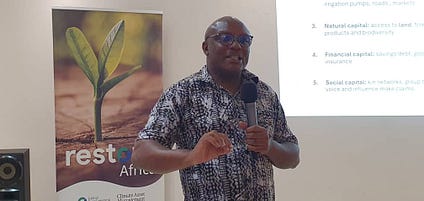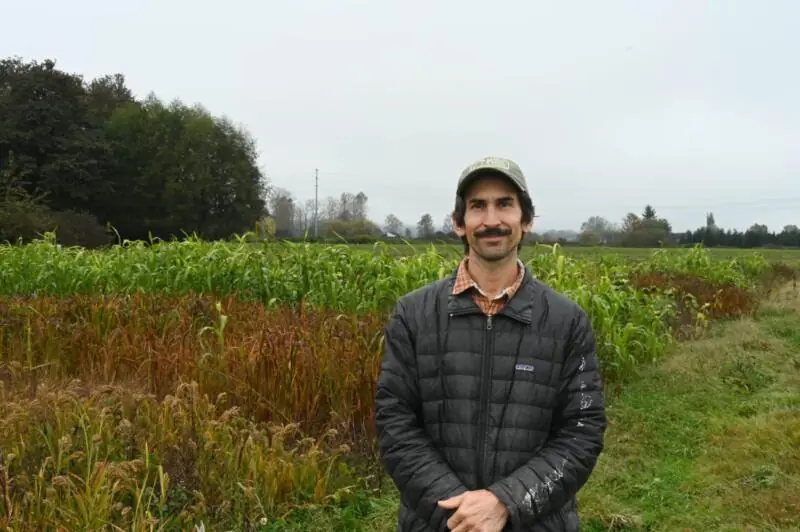Land Restoration Key to Environmental Preservation – AEJ – AfricaBrief

Report on Media Capacity Building for Land Restoration and Sustainable Development in Malawi
Executive Summary
A five-day training initiative was conducted in Mzuzu, Malawi, for members of the Association for Environmental Journalists (AEJ). The program aimed to enhance media capacity for reporting on land restoration, a critical issue for national development and environmental sustainability. The training highlighted the severe land degradation in Malawi, which affects approximately 7 million hectares, and underscored the urgent need for interventions that align with the Sustainable Development Goals (SDGs), particularly those related to poverty, hunger, climate action, and terrestrial ecosystems.
Alignment with Sustainable Development Goals (SDGs)
The land restoration efforts and associated media training in Malawi directly contribute to several key SDGs:
- SDG 15 (Life on Land): The core focus is on halting and reversing land degradation. The national strategy aims to restore 7 million hectares of degraded land, with progress already made on 4 million hectares, directly addressing Target 15.3 on combating desertification and restoring degraded land and soil.
- SDG 2 (Zero Hunger): Land degradation poses a significant threat to crop production and food security. By restoring agricultural land, the initiative supports sustainable agriculture and contributes to ending hunger.
- SDG 1 (No Poverty): The call for sustainable livelihood alternatives to activities like charcoal burning and firewood selling addresses the economic drivers of environmental degradation, aiming to provide sustainable income-generating options that reduce poverty.
- SDG 13 (Climate Action): Combating deforestation and promoting land restoration are integral to climate change mitigation and adaptation. The training empowers journalists to raise public awareness about climate change and its solutions.
- SDG 17 (Partnerships for the Goals): The initiative exemplifies a multi-stakeholder partnership, involving the AEJ, Catholic Relief Services (CRS), and Total Land Care, to achieve shared environmental and development objectives.
Key Stakeholder Interventions and Perspectives
- Association for Environmental Journalists (AEJ): President Titus Linzie emphasized that journalists are essential for disseminating messages on land restoration to the public. He stressed that economic necessity drives much environmental destruction and called for urgent interventions to promote sustainable livelihoods, aligning with SDG 1.
- Catholic Relief Services (CRS): Juma Masumba reported that 7 million hectares of land in Malawi are degraded, impacting food security (SDG 2). He noted that the ongoing land restoration initiative, stemming from a 2017 national strategy, has successfully restored approximately 4 million hectares, contributing directly to SDG 15. He identified journalists as vital partners in promoting behavioural change.
- Media Participants: Towera Katswiri, a journalist with Zodiak Broadcasting Station, affirmed the training’s importance. She stated that journalists have the power to raise awareness about climate change (SDG 13) and inspire a mindset shift towards environmental restoration among communities.
Training Program Overview
The comprehensive five-day program was structured to provide both theoretical knowledge and practical experience:
- Theoretical Component: Three days of classroom sessions held in Mzuzu, covering the principles and importance of land restoration.
- Practical Component: Two days of field-based practicals conducted in Mzimba District.
- Field Site Focus: Participants observed active restoration projects being implemented by Total Land Care, providing direct insight into successful interventions.
Conclusion and Strategic Outlook
The training program represents a strategic investment in building media capacity to support Malawi’s national development agenda. By equipping journalists with the necessary knowledge and skills, the AEJ and its partners are ensuring that land restoration and environmental protection remain central public and policy issues. Continued efforts in this area will be crucial for achieving Malawi’s environmental targets and contributing to the global Sustainable Development Goals.
Analysis of Sustainable Development Goals in the Article
1. Which SDGs are addressed or connected to the issues highlighted in the article?
-
SDG 15: Life on Land
- The article’s central theme is land restoration. It explicitly states, “We are talking about land restoration,” and highlights that “about 7 million hectares of land in Malawi are degraded.” The entire initiative described, involving organizations like Total Land Care and Catholic Relief Services (CRS), is focused on reversing this degradation.
-
SDG 2: Zero Hunger
- The article directly links land degradation to food security. It quotes Juma Masumba from CRS, who states that the degraded land “poses serious challenges to crop production and food security.” Therefore, the restoration efforts are crucial for ensuring sustainable agriculture and food availability.
-
SDG 13: Climate Action
- The connection to climate action is made through the journalists’ role in raising public consciousness. Journalist Towera Katswiri is quoted saying, “Journalists have the power to raise awareness about climate change, educate communities, and inspire mindset change that supports environmental restoration.” This highlights the importance of education and awareness in addressing climate change.
-
SDG 1: No Poverty
- The article identifies economic hardship as a primary driver of environmental destruction. AEJ president Titus Linzie notes that “many people destroy the environment out of economic necessity” through activities like “charcoal burning and firewood selling.” The call for “sustainable livelihood alternatives” directly addresses the need to alleviate poverty to protect the environment.
-
SDG 17: Partnerships for the Goals
- The initiative described is a collaborative effort involving multiple stakeholders. The article mentions the Association for Environmental Journalists (AEJ), Catholic Relief Services (CRS), and Total Land Care all working together on the land restoration project and training, which exemplifies a multi-stakeholder partnership for sustainable development.
2. What specific targets under those SDGs can be identified based on the article’s content?
-
Target 15.3: By 2030, combat desertification, restore degraded land and soil, including land affected by desertification, drought and floods, and strive to achieve a land degradation-neutral world.
- This is the most direct target. The article details a “land restoration initiative” that “has so far managed to restore approximately 4 million hectares of degraded land” out of a total of 7 million hectares needing restoration in Malawi.
-
Target 2.4: By 2030, ensure sustainable food production systems and implement resilient agricultural practices that… progressively improve land and soil quality.
- The article’s concern that land degradation “poses serious challenges to crop production and food security” directly relates to this target. Restoring land quality is a prerequisite for sustainable food production.
-
Target 13.3: Improve education, awareness-raising and human and institutional capacity on climate change mitigation, adaptation, impact reduction and early warning.
- The “five-day journalist training on land restoration” is a clear example of an activity aimed at building human and institutional capacity. The goal is for journalists to “raise awareness about climate change” and “educate communities,” which aligns perfectly with this target.
-
Target 17.17: Encourage and promote effective public, public-private and civil society partnerships, building on the experience and resourcing strategies of partnerships.
- The project itself, being a collaboration between civil society organizations (AEJ, CRS, Total Land Care), is a practical application of this target.
3. Are there any indicators mentioned or implied in the article that can be used to measure progress towards the identified targets?
-
Indicator 15.3.1: Proportion of land that is degraded over total land area.
- The article provides specific quantitative data that can be used for this indicator. It states that “about 7 million hectares of land in Malawi are degraded” and that the project has “managed to restore approximately 4 million hectares.” These figures directly measure the extent of land degradation and the progress of restoration efforts.
-
Indicators related to capacity-building for climate action (Target 13.3).
- While a specific indicator code is not mentioned, the article provides a clear metric for progress: the implementation of a “five-day journalist training on land restoration.” The number of journalists trained and the subsequent media reports on environmental issues could serve as practical indicators of increased capacity and awareness-raising efforts.
4. Table of SDGs, Targets, and Indicators
| SDGs | Targets | Indicators |
|---|---|---|
| SDG 15: Life on Land | Target 15.3: Combat desertification and restore degraded land and soil. | Indicator 15.3.1 (Proportion of land that is degraded): The article explicitly mentions that 7 million hectares are degraded and 4 million have been restored, providing direct data for this indicator. |
| SDG 2: Zero Hunger | Target 2.4: Ensure sustainable food production systems and improve land and soil quality. | Implied Indicator: Improved crop production and food security as a result of land restoration. The article identifies this as a key challenge the project aims to address. |
| SDG 13: Climate Action | Target 13.3: Improve education, awareness-raising and human and institutional capacity on climate change. | Implied Indicator: Number of capacity-building initiatives. The “five-day journalist training” is a specific activity that serves as a measure of progress. |
| SDG 1: No Poverty | Target 1.5: Build the resilience of the poor and reduce their vulnerability to environmental shocks. | Implied Indicator: Number of sustainable livelihood alternatives created to reduce dependency on activities like charcoal burning. |
| SDG 17: Partnerships for the Goals | Target 17.17: Encourage and promote effective civil society partnerships. | Indicator: The existence of the partnership between the Association for Environmental Journalists (AEJ), Catholic Relief Services (CRS), and Total Land Care. |
Source: africabrief.substack.com
What is Your Reaction?
 Like
0
Like
0
 Dislike
0
Dislike
0
 Love
0
Love
0
 Funny
0
Funny
0
 Angry
0
Angry
0
 Sad
0
Sad
0
 Wow
0
Wow
0















































/environment-climate-change-and-health-(ech)/water-sanitation-hygiene-and-health-(wsh)/landfill-tuvalu-36092.tmb-1200v.jpg?sfvrsn=5c21fe40_1#)


.jpg.webp?itok=0ZsAnae9#)






















